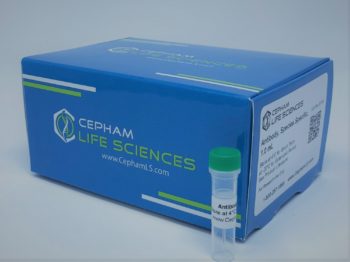Description
Aliases
NR3C3; PGR; PRGR
Antibody Type
Polyclonal Antibody
Uniprot ID
Swiss-Prot: P06401
NCBI Protein: NP_000917.3
Immunogen
Peptide sequence around phosphorylation site of serine 190 (G-L-S(p)-P-A) derived from Human Progesterone Receptor.
Raised In
Rabbit
Species Reactivity
Human
Tested Applications
WB IHC IF Recommended dilution: Predicted MW: 99kd, Western blotting: 1:500~1:1000, Immunohistochemistry: 1:50~1:100, Immunofluorescence: 1:100~1:200
Background / Function
Progesterone receptors (PRs) are nuclear hormone receptors of the NR3C class, which also includes mineralocorticoid,glucocorticoid and androgen receptors. They exist as homodimers coupled to Hsp90 or HMGB proteins, which are shed upon activation. The major signaling pathway used by progesterone receptors is via direct DNA binding and transcriptional regulation of target genes. They can also signal by binding to other proteins, mainly with transcription factors such as NF-kappaB, AP-1 or STAT. Progesterone receptors are found in the female reproductive tract, mammary glands, brain and pituitary gland and receptor expression is induced by estrogen. Well established functions of progesterone receptors include ovulation, implantation, mammary gland development and maintenance of pregnancy. In addition,progesterone, signaling through the progesterone receptor, increases the ventilatory response of the respiratory centers to carbon dioxide and decreases arterial and alveolar PCO2 in the luteal phase of the menstrual cycle and during pregnancy. The human gene encoding the progesterone receptor has been localized to 11q22.Narayanan R, et al. (2005) Mol Cell Biol; 25(8): 2885-98.Knotts TA, et al. (2001) J Biol Chem; 276(11): 8475-83.Clemm DL, et al. (2000) Mol Endocrinol; 14(1): 52-65.Zhang Y, et al. (1997) Mol Endocrinol; 11(6): 823-32
Conjugate
Unconjugated
Storage Buffer
Supplied at 1.0mg/mL in phosphate buffered saline (without Mg2+ and Ca2+), pH 7.4, 150mM NaCl, 0.02% sodium azide and 50% glycerol.
Form
liquid
Storage
Shipped at 4°C. Upon delivery aliquot and store at -20°C or -80°C. Avoid repeated freeze.
Purity
Antibodies were produced by immunizing rabbits with synthetic phosphopeptide and KLH conjugates. Antibodies were purified by affinity-chromatography using epitope-specific phosphopeptide. Non-phospho specific antibodies were removed by chromatogramphy using non-phosphopeptide.
Modification
Phospho-Ser190
Additional information
| Size | 100?l |
|---|


